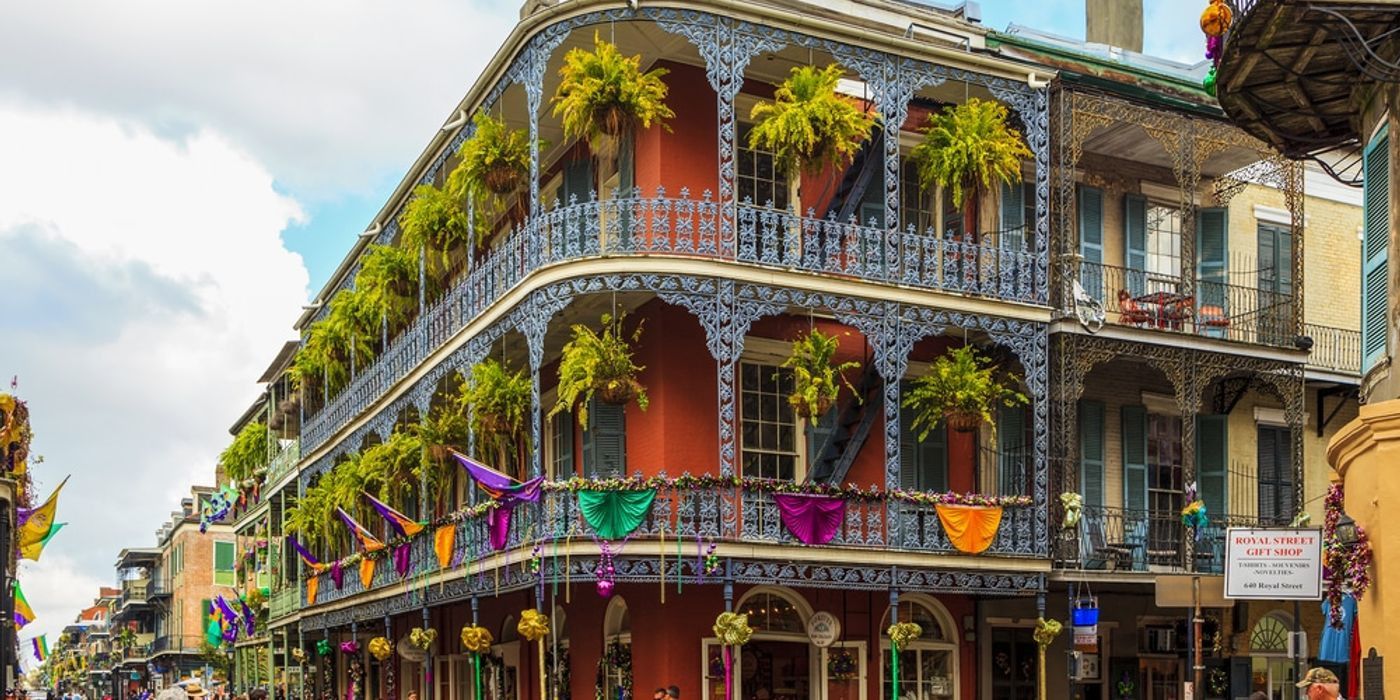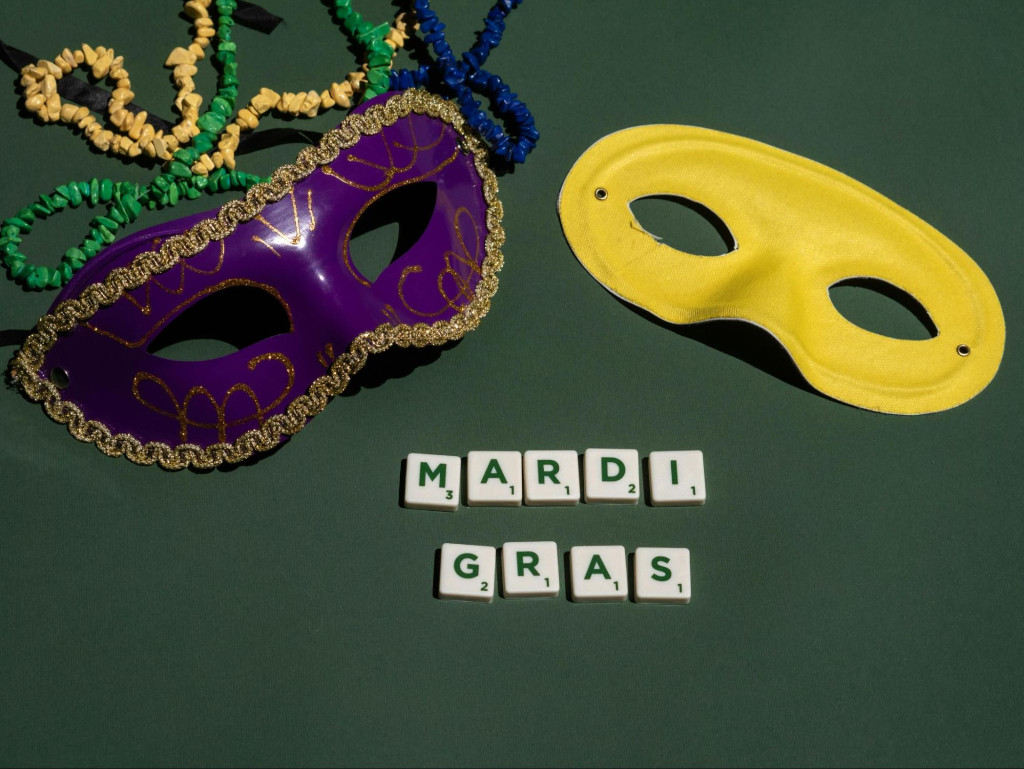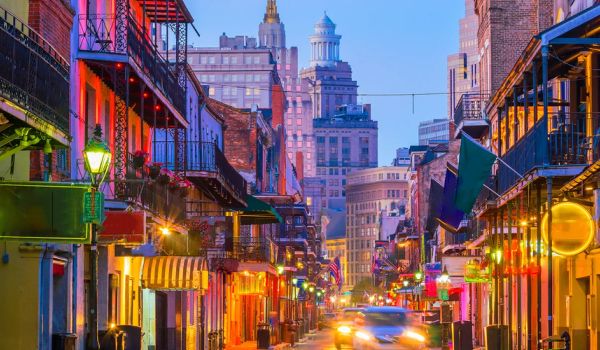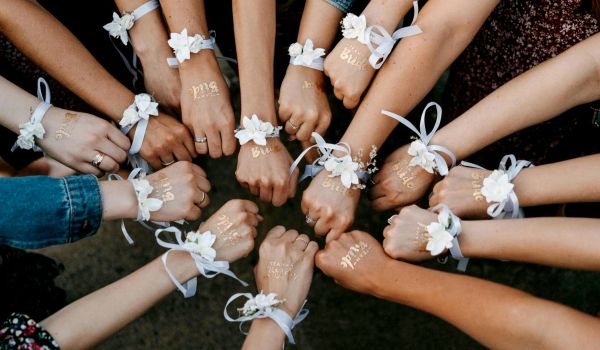
There’s nothing quite like Mardi Gras in New Orleans. One of the world’s most iconic celebrations – and definitely one of the most well-known experiences in New Orleans – Mardi Gras is a mix of parades, music, food, and local culture that takes over the city for an experience like no other.
Even if you’re a seasoned visitor, navigating the festivities can feel a bit overwhelming. That’s where this guide comes in – it’s your one-stop shop for everything Mardi Gras. From the history behind the celebration to insider tips on the best parades, safest spots, and what to wear, we’ve got you covered.
So grab your beads and let’s dive into everything you need to know to plan the ultimate Mardi Gras in New Orleans.
What is Mardi Gras?
French for “Fat Tuesday,” Mardi Gras is the culmination of the Carnival season, which begins on Twelfth Night on January 6th and ends with a final hurrah just before Lent begins on Ash Wednesday. Parades, music, balls, costumes, and celebrations occur throughout the entire Carnival season, but Mardi Gras itself is technically the final day, Fat Tuesday.
The History of Mardi Gras
While the origins of Mardi Gras can be traced all the way back to Medieval Europe, the tradition of Mardi Gras in New Orleans began in the early 1700s when French explorers brought the celebration to Louisiana.
Over time, the festivities evolved into Mardi Gras as we know it today. The first Mardi Gras parade was held in New Orleans by the Krewe of Comus in 1857, and in 1870, Mardi Gras’ second Krewe, the Twelfth Night Revelers, began tossing “throws” (more on these iconic parts of Mardi Gras later).
As Mardi Gras in New Orleans became more and more popular, the governor of Louisiana signed the “Mardi Gras Act” in 1875, making Fat Tuesday an official holiday.
When is Mardi Gras? Why Does the Date Change Every Year?
Because it’s tied to the Christian calendar (and Easter specifically), the date of Fat Tuesday changes every year, and so does Mardi Gras! Mardi Gras always falls 47 days before Easter Sunday, which means it can land anywhere between February 3rd and March 9th.
Some people refer to Carnival and Mardi Gras interchangeably, although Carnival technically stretches the whole season from January 6th to Fat Tuesday, while Mardi Gras is Fat Tuesday itself. No matter when Fat Tuesday falls in a given year, there is an entire Carnival season leading up to it, filled with weeks of parades, parties, and celebrations, giving you plenty of time to experience the festivities.
Here in New Orleans, we generally refer to Mardi Gras as the two weekends leading up to Fat Tuesday, when the celebrations reach new heights. Most visitors come the weekend before Fat Tuesday for the biggest parades and parties.
When to Visit for Mardi Gras in New Orleans
You can visit any time during Carnival (between January 6th and Fat Tuesday) to experience parades and festivities. But if you want the true Mardi Gras experience (the one most people are thinking of when they picture Mardi Gras in NOLA), most people book a stay beginning the weekend before Fat Tuesday.
If you arrive in New Orleans on the Wednesday before Fat Tuesday and leave on Ash Wednesday, you’ll be able to make the most of your trip.
The Best Mardi Gras Parades in New Orleans
What is a Krewe?
At the heart of Mardi Gras in New Orleans are the Krewes. Long story short, the Krewes are the organizations behind the Mardi Gras parades and events. There are hundreds of Krewes in New Orleans! Some have been around for decades while others are entirely new. With different historical significance, traditions, themes, sizes, parade types, and signature “throws,” there is a lot to discover about these groups.
Each Mardi Gras Krewe has its own parade, reflecting its unique history, culture, and theme. They’ll often host a follow-up ball for members of the Krewe, many of which are super exclusive and invite-only, adding to the Krewe’s mystique.
It’s the dedication of the Mardi Gras Krewes to up-leveling their creativity each year and putting on a show for every single parade that truly makes Mardi Gras come alive.
Mardi Gras Parade Schedules
Each year, the Mardi Gras parade schedule varies. Parades run for several weeks, from Twelfth Night on January 6th to Fat Tuesday (which is a different date each year based on Easter).
Most of the major parades take place in the two weeks leading up to Mardi Gras, with the biggest ones happening on the weekend before Fat Tuesday, making it the most popular time to visit for those who want the full Mardi Gras experience.
If you’re planning to attend a parade during Carnival (or even if you’re just visiting New Orleans during the season), be sure to look into parade schedules and routes in advance so you know where to be (and not to be).
Favorite Mardi Gras Parades
There’s no shortage of incredible parades to enjoy during Mardi Gras, but some stand out as absolute must-sees. These are the parades happening directly leading up to and on Fat Tuesday, from some of the biggest and most well-known Krewes, featuring the most intricate, massive, and extravagant floats and sought-after signature throws.
Endymion (Saturday before Mardi Gras): Known for its massive, elaborate floats and celebrity riders.
Bacchus (Sunday before Mardi Gras): Famous for its theatrical themes and larger-than-life parade features.
Orpheus (Monday before Mardi Gras): Known for creative floats and sought-after throws like four-foot stuffed dragons and custom-decorated tambourines.
Zulu (Mardi Gras Day): Beloved for its unique throws, including the iconic hand-decorated coconuts.
Rex (Mardi Gras Day): One of the oldest and most traditional parades, featuring a regal, timeless charm.
Most Unique Mardi Gras Parades
If you’re looking for something a little different, don’t miss these offbeat parades:
Krewe du Vieux: Known for its biting satire, adult humor, and political comedy, plus some of the best jazz and brass bands around.
Chewbacchus: A sci-fi and pop-culture-themed parade that celebrates Star Wars and other popular fandoms in the most fun way possible.
Barkus: A dog parade in the French Quarter featuring costumed pups as the stars of the show.
Krewe of Tucks: Known for its satirical humor and playful vibe, including toilet-themed floats and quirky throws.
Kid-Friendly Mardi Gras Parades
Mardi Gras is for all ages, and there are plenty of parades perfect for families with young children:
Krewe of Little Rascals): A family-friendly parade with child riders and fun themes.
Krewe of Thoth: An early parade that’s perfect for kids, thrown by a Krewe that does an incredible amount of volunteer work for the children’s hospital, this one has a unique route that’s lots of fun.
Krewe of Iris: The oldest all-female Krewe, with a focus on elegance and tradition, perfect for families.
Krewe of Mid-City: Known for its vibrant floats and upbeat atmosphere that kids love.
A few tips for families:
- The Uptown parade route offers lots of space to set up chairs and blankets, making it easier to enjoy the parades comfortably. You’ll see families having picnics, playing games, and having fun while waiting for the parades.
- You can also view many of the parades when they begin on St. Charles Avenue near Napoleon, rather than waiting for them to make their way past you further down the route.
- Family Gras is a free family-friendly celebration that takes place two weekends before Fat Tuesday in the Metairie neighborhood on Veterans Memorial Boulevard (across from Lakeside Shopping Center). There are parades, authentic cuisine, local art, a kids’ court with children’s activities, and free outdoor concerts and entertainment. Grab some jambalaya or gator-on-a-stick and catch the parades as they pass by.
- Mardi Gras can be very family-friendly – just make sure to avoid the French Quarter with kids. During Carnival, this popular tourist spot is full of adults-only revelry.
Navigating Mardi Gras in New Orleans
What is “In the Box”?

When planning your Mardi Gras experience, you’ll hear a lot about the “box.” This is the area between Canal Street and Napoleon Avenue along the parade routes. The box is a no-driving zone, closed to vehicular traffic, during parades. It’s also impossible to get an Uber or Lyft in the box, so you’ll need to walk outside the box to get picked up.
You’ll find the largest crowds in the box, but it’s also got the most high-energy atmosphere, perfect for visitors who want the full Mardi Gras experience. If you want a little more of a relaxed experience with a local, laid-back vibe, you’ll want to hang out beyond the box, above St. Charles Ave, where it’s less crowded and more family-friendly.
Transportation Tips for Mardi Gras
If you’re visiting NOLA during Mardi Gras, getting around requires some planning since many streets are closed for parades. The best way to get around is by using public transportation, ride shares, or your good old feet.
Pro Tip: Stay near the parade routes to save your energy for the festivities.
Driving: During Mardi Gras weekend, the French Quarter is closed to vehicular traffic and parking anywhere nearby will be hard to find, so driving and parking your own car is not the best way to get around. In fact, traffic during the entire Carnival season is incredibly congested and there are often barricades set up in different locations to try to redirect traffic around parades and such.
Public Transportation: If you’re using public transportation, be sure to check streetcar and bus routes and schedules, as they often change during Carnival season. Use the RTA GoMobile app for updates.
Ride Share: Services like Uber and Lyft are available, but expect surge pricing and longer wait times during peak parade hours. As mentioned above, you’ll have to make sure you’re out of “the box” to be able to call Uber or Lyft, and even then it can be hard to catch a ride.
Walking or Biking: If you’re staying close enough to the action, walking or renting a bike is really your best bet. Though if you do ride your bike, be sure to lock it up when not in use.
If you’re staying with us at Book NOLA, we’re happy to help you figure out the best way to navigate the city during your Mardi Gras stay.
Where to Stay for Mardi Gras in New Orleans
Book your Mardi Gras trip well in advance to make sure you have accommodations.
With so much happening, staying near the action can make your Mardi Gras trip much easier.
Uptown: Ideal for being close to parade routes while enjoying a quieter neighborhood vibe, great for families.
Central Business District: Perfect for those who want to be in the heart of the action, right on the edge of the French Quarter, though this is a busier area.
Mid-City: A good middle ground with easy access to both parades and local attractions.
Vacation rentals are an excellent choice, offering comfort, space, and amenities for groups or families. Browse our Book NOLA properties to find the New Orleans vacation rental that’s perfect for your visit. Book early—Mardi Gras accommodations, especially those near the parade route, fill up fast!
Insider Tips for Mardi Gras in New Orleans
Mardi Gras Tickets
You might be wondering… Do I need tickets for Mardi Gras in New Orleans? And the answer is NO! Mardi Gras parades and celebrations are completely free, which is why it’s often called The Greatest Free Celebration on Earth.
If you want to sit on the stands as the parades go by, that’s another story. You’ll need to purchase tickets to reserve a seat. But that’s totally not necessary – you can view all of the parades for free. We’d only recommend purchasing seats for those who may have trouble standing for long periods of time.
Safety Tips
Mardi Gras is all about fun, but with big crowds and lots of activity, it’s important to stay safe while enjoying the festivities. Here are some practical tips.
Stick Together: Stay with your group, especially in crowded areas. It’s easy to get separated, so agree on a meeting spot just in case.
Keep Valuables Secure: Use a crossbody bag or fanny pack to keep your belongings close. Avoid carrying large amounts of cash or valuables and keep an eye on your belongings to avoid pickpocketing.
Charge Your Phone: A fully charged phone is essential for staying connected with your group and navigating the city. Bring a portable charger, just in case.
Be Aware of Your Surroundings: Watch your footing around floats and barricades, and keep an eye out for traffic if you’re crossing streets outside parade areas.
Drink Responsibly: Mardi Gras is known for its party atmosphere, but it’s important to pace yourself and stay hydrated. Always know your limits.
Keep Kids Away From the FQ: During Mardi Gras, the French Quarter transforms into an adult-only area where risque behavior is part of the fun. Think revealing costumes, flashing for beads, etc. There are plenty of ways for kids to enjoy Mardi Gras, but the French Quarter is not one of them.
Stand Back for the Bands: When the parades roll through, you can get well into the street, right up to the floats. But be sure to stand behind the curb when the bands come through. Not only will the chaperones yell at you to get back, but the drummers will not hold back swinging their drumsticks and you just might get hit in the face.
What to Wear
New Orleans weather during Mardi Gras can be unpredictable, varying from cold to hot, sometimes even on the same day. It’s a good idea to wear layers. You’ll also likely be walking and standing for long periods, so pack comfortable shoes like sneakers or supportive flats.
It’s also a good idea to check the weather and be prepared for rain if necessary. A lightweight poncho, raincoat, or umbrella might be in order if there’s rain in the forecast. Parades still roll in light rain.
The last thing to consider when planning what to wear for Mardi Gras is to show some spirit! From costumes, masks, and accessories, to simply wearing purple, green, and gold (the official colors of Mardi Gras), dressing up is part of the fun.
Parade Watching Spots
Choosing the right spot to watch the parades can make or break your experience. Some top recommendations include:
Lafayette Square (in the box): A lively spot with plenty of amenities nearby.
St. Charles Avenue (out of the box): Perfect for a more relaxed, family-friendly atmosphere.
Canal Street: Great for being in the middle of the action and close to the French Quarter.
Arrive early to claim your spot, especially for the big parades, and bring chairs or blankets.
When to Get to the Parades
If you really want a good spot to watch a popular parade, you’ll need to get to the parade route hours ahead of time (but not more than 4 hours before). On the weekend before Fat Tuesday, the biggest, most popular parades roll (like Bacchus on Sunday night), and if you want to be in the front row for that, you’ll basically need to hang out and save your spot all day (Thoth rolls early that day, so you’re allowed to be camped out on the route all day long). Of course, you don’t have to get there so early, but know that you’ll be a few rows deep if you show up later.
Catching Throws
We’ve mentioned throws throughout this guide, but let’s dive into exactly what they are. Throws are beads, cups, doubloons, stuffed animals, and signature items thrown by float riders into the crowd – and trying to catch them is part of the fun of Mardi Gras.
First of all, bring a bag to carry all the goodies you collect – there will be a lot of them! Next, make eye contact with riders, wave, smile, hold up a sign saying where you’re from, or yell out asking them to throw something! Most throws will be beads, cups, and small items, but look out for unique, highly coveted signature items like Zulu coconuts, Muses glittered shoes, and Orpheus stuffed dragons.
If you miss the throw and it lands on the floor, don’t reach down to pick it up! Put your foot on it and wait to grab it until a safe moment, like between floats. Avoid grabbing items off the ground, and don’t get into a tug-of-war with other people over anything – it’s not worth it, and there will be more coming as the next float rolls by.
The Mardi Gras Experience Beyond Parades
No Mardi Gras experience is complete without indulging in a slice (or three) of King Cake. This colorful treat is a staple of Carnival season, decorated in the iconic purple, green, and gold sugar that represents justice, faith, and power.
The King Cake tradition traces its roots to France and Spain, where similar cakes were served to celebrate the Feast of Epiphany (when Carnival season begins). In New Orleans, the King Cake has become a symbol of Mardi Gras, with bakeries and cafes putting their unique spin on the classic recipe.
Inside each King Cake is a tiny plastic baby. Tradition says that whoever finds the baby in their slice is crowned “king” or “queen” for the day and tasked with buying the next King Cake or hosting the next celebration. It’s a fun way to keep the festivities going all season long!
For an authentic taste of Mardi Gras, check out local favorites like Dong Phuong Bakery,
Manny Randazzo’s, and Bywater Bakery.
Balls & Events
Beyond the parades, Mardi Gras is filled with exclusive balls and lively public events. Each Krewe hosts a ball to celebrate the season, many of which feature royal courts, formal attire, and elaborate performances. Most are private and invite-only, making them super exclusive.
For visitors, there are a few public balls and events to enjoy, such as:
Endymion Extravaganza: A massive, star-studded event featuring live music and celebrity appearances like Katy Perry, Train, Sting, Flo Rida, Darius Rucker, Kelly Clarkson, Carrie Underwood, and more.
Bacchus Bash: A big all-day Mardi Gras block party on Super Sunday (the Sunday before Mardi Gras) featuring live music, DJs, and VIP open bar ticket options.
Orpheuscapade: A black-tie affair hosted at the Convention Center, with table seating, drink set-ups, and up-close parade viewing.
Music & Local Culture
As you stroll through the French Quarter or Uptown during Mardi Gras, you’ll often be able to catch live music and street performances that add to the celebration. New Orleans is world-renowned for its music, and during Mardi Gras the city comes alive with brass bands, jazz, and impromptu street performances, turning every corner into a stage. If you want to immerse yourself in NOLA’s legendary music scene, head to spots along Frenchmen Street, Bourbon Street, and Jackson Square.
Mardi Gras in New Orleans

Mardi Gras is more than just a celebration – it’s a cultural phenomenon that captures the spirit of New Orleans like nothing else. From unforgettable parades and live music to rich traditions like King Cake, Krewe balls, and catching throws, every moment is an opportunity to immerse yourself in Carnival.
Ready to start planning your trip? Our vacation rentals put you right in the heart of the action, offering a comfortable and convenient home base for all your Mardi Gras adventures. Book your stay today, and get ready to create memories as colorful as the beads you’ll catch!
Laissez les bons temps rouler—let the good times roll!
Latest Articles

6 Best Neighborhoods to Stay in New Orleans

Best Time to Visit New Orleans: Weather, Festivals & Travel Tips by Month

A Local’s Guide to Planning the Ultimate New Orleans Bachelorette Weekend

